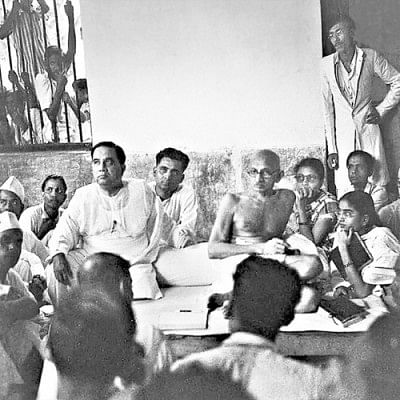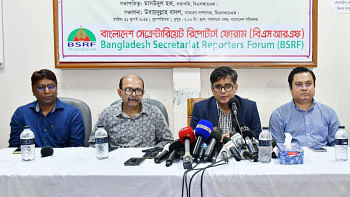Secularism past, secularism present

The emergence of Bangladesh as an independent state on December 16, 1971 was a major event in the political history of the subcontinent, whose significance needs to be studied from different perspectives. This does not mean an immersion in the past, but rather an exercise for the future.
The legacy of the past has greatly influenced the postcolonial development of the newly independent nations. The colonial legacies of India, especially in the first half of the 20th century, has been determined by diverse factors, but the rupture in the body politic was most evident on the issue of Hindu-Muslim relations. The end of colonial domination in 1947 was not a celebration, rather it was a "chequered mourning" as poet Faiz Ahmed Faiz depicted. Independence was marred by unprecedented violence and the period remained engraved in people's minds, not as the first day of freedom but as the time of Partition. India was divided on religious lines to carve out Pakistan as a land of the Muslims of India, with the declared aim to solve the Hindu-Muslim conflict once and for all. Pakistan became an Islamic republic while India proclaimed itself as a secular democratic state.
The acceptance of partitioning the land to separate the Muslims and Hindus as two contesting religious groups who failed to define their life together as a community, has opened the path to disrupting the communal harmony essential for the development of society. The result is evident in the subsequent developments in the subcontinent, which showed that the line of separation was drawn not only on the map but also in the minds and psyches of communities everywhere. Moreover, Pakistan as a country defined its neighbour as a Hindu state, the other part of its two-nation theory. Right from the beginning, India also failed to establish a healthy relationship with its neighbour. The tension between the two states culminated into bloody riots in 1950 and 1964, as well as brutal wars in 1948 and 1965.
In this backdrop, the role of the Bengali people, specifically the Bengali Muslims, needs to be analysed in historical context. There are myths created by various quarters which have been busted by later day historical developments. The emergence of Bangladesh as a secular republic upholding its national identity was a landmark event, a clear departure from the two-nation theory and the postcolonial reality of communal conflict. Thus, the concept of secularism as one of the fundamental principles of the state showed the path to the future, amending the rupture in the subcontinental body politic.
Bengali Muslims, who voted overwhelmingly for Muslim League and endorsed the creation of Pakistan, became disillusioned very soon. This is the common belief that mainstream historians are putting forward for long and has become a kind of meta-narrative. But if we take a deeper look at the historical events of the time, we will be able to identify the other narratives that help us to explain the journey made by Muslim communities at large. A careful reading of The Unfinished Memoirs by Bangabandhu Sheikh Mujibur Rahman reveals what Pakistan meant to Mujib, then a young activist of the Muslim League and the undisputed leader of the students of Islamia College of Kolkata, who can rightly be considered as the voice of the educated Muslim youth. He belonged to Muslim League, but to the other faction of the League, led by Suhrawardy and Abul Hashim, both related to each other and belonging to the Muslim gentry, and more concerned with Muslim rights than a separate homeland for Muslims. Their vision of a separate homeland was a Muslim majority united Bengal, where Hindus and Muslims could live as a composite community.
Bangabandhu quoted the Lahore resolution verbatim to highlight its call for independent states to be formed in the Western and Eastern part of India where the Muslims were a majority. His vision of Pakistan was not a Muslim dominated state, but a space where both communities would live together in peace and harmony with equal rights. During the heydays of the struggle for Pakistan, Sheikh Mujib could easily endorse the idea of united or akhanda Bengal as proposed by Sarat Bose and Suhrawardy. However, the move never got momentum and soon Bengali society became entangled in bloody riots in Kolkata on August 16, 1946, followed by riots in the rural hinterland of Noakhali, and subsequently in Bihar. Society dived into a deep abyss and Hindu-Muslim unity became a dream never to be fulfilled. The dark scenario blinded the politicians to look beyond the existing reality and search for other options. Bengal and Punjab were partitioned on the basis of the religious identity of the people. Partition happened to stop the violence, but it brought more violence and death. The mad frenzy quickly culminated in the absurd policy of population exchange, where under the interim administration, the total Muslim population of East Punjab was taken to West Punjab and vice versa for the Hindus and Sikhs of West Punjab.
The birth of independent India and Pakistan has been marred with blood and the memory of Partition is one of victimisation unbound. The suffering it brought to millions still haunt us. But what is overlooked is that in 1947, when Punjab burnt and bled, Bengal was peaceful. Riots erupted in Bengal later in 1950, resulting in indiscriminate killings and mass exodus. At that time, a few of the right-wing politicians called for population exchange, but fortunately, that didn't happened. In historical narratives, not much attention is given to Bengal in 1947. It is also important to look where leading politicians stood in mid-August, 1947. We found Mahatma Gandhi in Kolkata, calling for peace between Hindus and Muslims. As a mark of his political action, he spend the day fasting at the Haideri Manjil, the Muslim house at Beliaghata which was looted and burnt by the rioters in August of the previous year. A photograph found many years later showed Gandhi sitting on the floor with Suhrawardy at his side and the lanky young man standing at the door was Sheikh Mujib.
The day when India was divided, Mujib was standing not with politicians blinded by their communal outlooks, but with a handful of leaders who defied the prevailing mood. They represented the future, and the emergence of Bangladesh as a secular state has endorsed that dream which few others could uphold and struggled for.
Bangladesh, a Muslim majority country, opted for secularism as an essential part of its national identity. In the name of creating an Islamic state and its purity, the Pakistani rulers adopted the policy to impose a sole religious identity, obliterating the cultural-linguistic traditions of our people. That contradiction was there right from the beginning and national identity and culture became the rallying point for the survival of the nation. Nationalism with a strong cultural component united the people and Sheikh Mujib transformed that unity into a massive political struggle. A poster of the Bangladesh government during the war depicted the secular basis of the Bangladeshi state eloquently as it proclaimed: Hindus, Buddhists, Christians and Muslims of Bengal—we are all Bengali. Thus religion and nationalism are mingled together, creating spaces for all. In the strife-ridden reality of today, the state of Bangladesh points the way to the future of peace, tolerance and harmony with its commitment to secularism. The ideal needs to be protected under all circumstances.
Mofidul Hoque is a war crimes researcher and trustee of the Liberation War Museum.

 For all latest news, follow The Daily Star's Google News channel.
For all latest news, follow The Daily Star's Google News channel. 



Comments